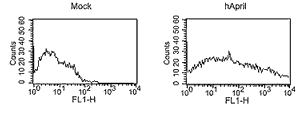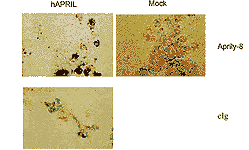Product Details
| Alternative Name: | A-Proliferation-inducing ligand, TNFSF 13, CD256 |
| |
| Clone: | Aprily-8 |
| |
| Host: | Mouse |
| |
| Isotype: | IgG1 |
| |
| Immunogen: | Recombinant human APRIL (aa 93-233). |
| |
| UniProt ID: | O75888 |
| |
| Source: | Purified from concentrated hybridoma tissue supernatant. |
| |
| Species reactivity: | Human
|
| |
| Specificity: | Recognizes APRIL and TWE-PRIL. |
| |
| Crossreactivity: | Does not cross-react with mouse APRIL or TWE-PRIL. |
| |
| Applications: | Flow Cytometry, ICC, IHC (PS), IP, WB
|
| |
| Application Notes: | Excellent for Immunocytochemistry and Western Blot. |
| |
| Formulation: | Liquid. In PBS containing 0.02% sodium azide. |
| |
| Use/Stability: | Stable for at least one year after receipt when stored at -20°C. |
| |
| Handling: | Avoid freeze/thaw cycles. |
| |
| Shipping: | Blue Ice |
| |
| Short Term Storage: | +4°C |
| |
| Long Term Storage: | -20°C |
| |
| Regulatory Status: | RUO - Research Use Only |
| |

Figure 1: Western blot of total cell extracts from HEK 293 cells transfected with the indicated expression vector. Aprily-8 reacts specifically with human APRIL.Method: 10µg of protein was applied to the gel. Revealed with Aprily-8 (1µg/ml) and HRP-coupled anti-mouse secondary antibody (1:4’000).Note: The human APRIL construct used in this experiment is an uncleavable fusion protein between human BAFF (aa 1-132) and human APRIL (aa 93-233).

Figure 2: FACS analysis of cells with MAb to APRIL (Aprily-8).Method: HEK 293 cells were mock transfected or transfected with an expression plasmid coding for a non-cleavable human APRIL. Cells (5x105) were incubated on ice for 30 min. in 50µl FACS buffer (PBS, 5% fetal calf serum, 0.02% azide) containing 10µg/ml of Aprily-8 antibody. After washing in FACS buffer, FITC-conjugated antibody to mouse IgG was added. Cells were incubated on ice for 30 min., washed and analyzed by flow cytometry.

Figure 3: Immunostaining of HEK 293 cells transfected with a human APRIL expression plasmid (left panels), or mock transfected (right panel) by Aprily-8.Method: 3 days after transfection of cells with the indicated constructs, cells were fixed with 4% formaldehyde 5 min. at RT. After a wash in PBS, samples were dehydrated by washes in 60%, 80%, 90%, 100% EtOH and xylol. Cells were then dried and embedded in paraffin. Sections were cut, mounted on slides and dried overnight at 50°C. Slides were then successively washed 2x 10 min. in xylol, 2x 10 min. in 100% ethanol, and then treated 10 min. in 100% methanol/0.6% H202 to inhibit endogenous peroxidase. Samples were rehydrated by washes in 90%, 80%, 60% ethanol and PBS. After micro-wave treatment, slides were washed 3x in PBS, blocked with IgG, and incubated for 1 hour with 5µg/ml Aprily-8 or control mouse IgG (isotype control) in 1%BSA / 1x PBS for 1 hour. After PBS washes, samples were incubated with the secondary Ab for 1 hour, washed in PBS and revealed with StreptABComplex/HRP (Vector) and AEC.
Please mouse over
Product Literature References
APRIL binding to BCMA activates a JNK2-FOXO3-GADD45 pathway and induces a G2/M cell growth arrest in liver cells: G. Notas, et al.; J. Immunol.
189, 4748 (2012),
Abstract;
Detection of the TNFSF members BAFF, APRIL, TWEAK and their receptors in normal kidney and renal cell carcinomas: V. Pelekanou, et al.; Anal. Cell. Pathol. (Amst.)
34, 49 (2011),
Abstract;
Adipocytes as immune cells: differential expression of TWEAK, BAFF, and APRIL and their receptors (Fn14, BAFF-R, TACI, and BCMA) at different stages of normal and pathological adipose tissue development: V.I. Alexaki, et al.; J. Immunol.
183, 5948 (2009),
Abstract;
Expression of TNF-superfamily members BAFF and APRIL in breast cancer: Immunohistochemical study in 52 invasive ductal breast carcinomas: V. Pelekanou, et al.; BMC Cancer
8, 76 (2008),
Abstract;
Full Text
General Literature References
BAFF and APRIL: A Tutorial on B Cell Survival: F. Mackay, et al.; Annu. Rev. Immunol. (2002),
Abstract;














